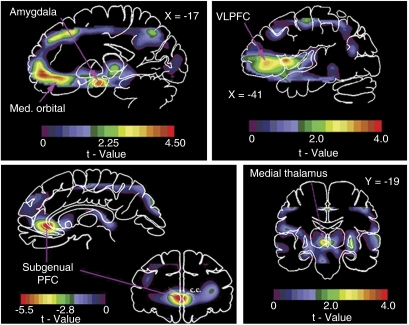Figure 8.
Areas of abnormally increased physiological activity in familial MDD shown in images of unpaired t-values, computed to compare activity between depressives and controls (Drevets et al, 1992, 1997a). Upper left: positive t-values in a sagittal section located 17 mm left of midline (X=−17) show areas where CBF is increased in depressives vs controls in the amygdala and medial (MED) orbital cortex (reproduced from Price et al, 1996). Upper right: positive t-values in a sagittal section 41 mm left of midline (X=−41) show areas where CBF is increased in depressives in the left ventrolateral PFC (VLPFC) areas corresponding approximately to the intrasulcal portion of BA 47 (area 47/12s) and to BA 45a (reproduced from Drevets et al, 2004a). Lower right: positive t-values in a coronal section located 19 mm posterior to the anterior commissure (Y=−19) shows an area where CBF is increased in depressives in the left medial thalamus (from Drevets and Todd, 2005b). Lower left: coronal (31 mm anterior to the anterior commissure; Y=31) and sagittal (3 mm left of midline; X=−3) sections showing negative voxel t-values in which metabolism is decreased in depressives vs controls. The reduction in prefrontal cortex (PFC) activity localized to in the anterior cingulate gyrus ventral to the genu of the corpus callosum (ie, subgenual) (Table 1; reproduced from Drevets et al, 1997a). Anterior or left is to left.

